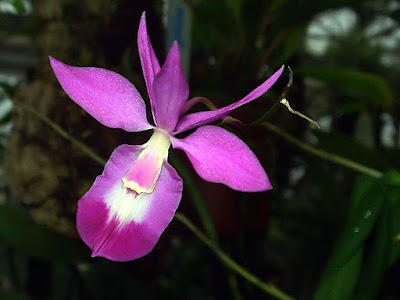Barkeria scandens is native to Mexico. The plants meet on the slopes directed towards the Pacific, in the states of Michoacan, Guerrero and Oaxaca. They grow on rocks, on trees and small bushes at heights of 1000-2000 m...
Barkeria scandens also called as The Scandent Barkeria, Barkeria cyclotella, Barkeria lindleyana var. cyclotella, Epidendrum cyclotellum, Epidendrum lindleyana var cyclotellum, Pachyphyllum scandens, is a species of the genus Barkeria. This species was described by Robert Louis Dressler & Federico Halbinger in 1977.
IDENTIFY BARKERIA SCANDENS
Barkeria scandens is native to Mexico. The plants meet on the slopes directed towards the Pacific, in the states of Michoacan, Guerrero and Oaxaca. They grow on rocks, on trees and small bushes at heights of 1000-2000 m.
It is a small to large sized, cool growing twig epiphyte or lithophyte, which reaching 8-15 cm in height, with sympodial ascending, cylindrical, 8-15 cm long stems enveloped by close fitting sheaths and carrying 3 to 8, distichous, deciduous, fleshy, ovate-elliptic to lanceolate, acute to subacute, obtuse-subcordate below, green suffused with purple, carinate beneath, 5-10 cm long and 1.5-3.5 cm wide leaves.
The Scandent Barkeria blooms in the fall on a terminal, racemose, very thin, subterete, 10 to 55 cm long, densly 2 to 18 flowered inflorescence. The flowers are 3.0-4.5 cm in diameter, intensely purple-red color and white thickening on the lip. The lip has three bulges extending almost from the base to the apex and is connected to the rod. The rod is widely spread, thin wings. Sometimes the back has many dark purple spots.
BARKERIA SCANDENS CARE AND CULTURE
Cultural information should only be used as a guide, and should be to be adapted to suit you. Your physical location; where you grow your plants, how much time you have to devote to their care, and many other factors, will need to be taken into account. Only then can you decide on the cultural methods that best suit you and your plants.
Light:
Barkeria scandens needs a light level of 25000-40000 lux. A high level of light is required, but it should be dispersed or filtered. Probably, the plants will be in better condition if they are not exposed to the direct action of the southern sun. Strong air movement must be ensured all the time, especially if grown at high levels of light. If you have a cool humidifier, these plants will feel well placed near the outlet of cool, humid air.
Temperature:
The average temperature of the summer day is 27-28 ° C, the night 15-16 ° C, and the daily difference is 12-13 ° C. The average temperature of the winter day is 25-27 ° C, the night 8-10 ° C, and the daily difference is 16-17 ° C.
Humidity:
In the summer and early autumn, The Scandent Barkeria needs the average humidity of 70-75%, but in the winter and at the beginning of spring it drops to 55-60 %.
Substrate, growing media and repotting:
Barkeria scandens are best grown on cork or tree fern rootstock, if it is possible to provide high humidity and watering in summer at least once a day. During hot, dry weather, it may be necessary to water several times a day.
The plants also grow very well mounted on the branches, run horizontally, in quite shady places. If you can not mount the plants, you can grow them in small, shallow pots or baskets with a very airy substrate. Although the pots are not growing well, some plants of the Barkeria genus are able to adapt to growing in baskets, if we use a small amount of very thick substrate, such as pieces of tree fern.
Watering:
From spring to autumn the rainfall is abundant, but then their number drops sharply and the period of 5-6 month winter dry season follows. The cultivated plants should be abundantly watered during active growth, at least once a day if the weather is hot and the level of light is high, but their roots must dry quickly. When new growths reach maturity in autumn, the amount of water should be reduced.
Fertilizer:
In the period of active growth, a balanced fertilizer should be used, in 1/4-1/2 doses of fertilizer for orchids. You can also use phosphate-enriched fertilizer from mid-summer to the end of autumn to improve flowering in the next season and strengthen new growth before winter.
Rest period:
In winter and early spring, Barkeria scandens should be considerably limited to the amount of water, but they can not remain completely dry for too long. Occasional morning fogging, especially in sunny weather, will provide the plants with enough moisture and prevent excessive drying. Fertilization should be eliminated until new growths appear in the spring and normal watering begins.















COMMENTS